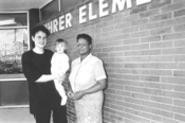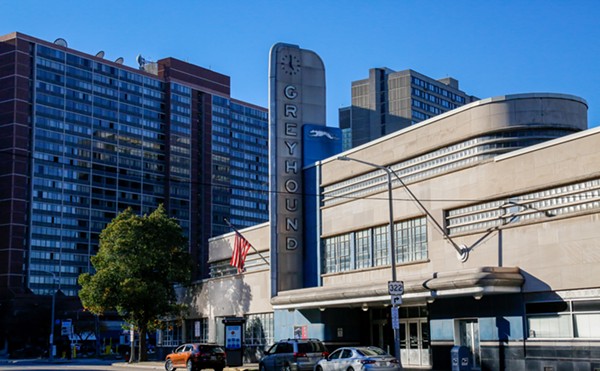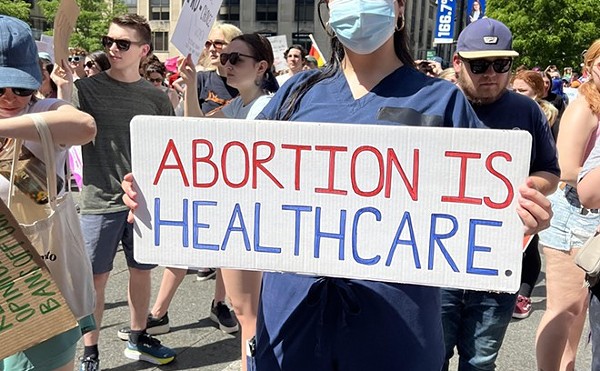On May 8, when Clevelanders vote on whether to raise their property taxes to repair the city's schools, Walton's parents and their neighbors may be the most important voters of all. While East Siders reliably vote heavily in favor of school levies and Cleveland's far West Side always turns out against them, near West Side neighborhoods like Walton's are the swing area. Five years ago, the last time Cleveland approved a school tax, the vote in the Clark-Fulton neighborhood around Walton split almost evenly.
Deborah Washington pauses outside Walton, holding her shy son's hand, on her way to her car to pick up her daughter at an arts school. She's heard about the ballot issue on the radio, but she isn't sure how she'll vote.
"I want to vote for it," she says. "There's a lot of improvements needed. This one" -- she gestures toward Walton -- "doesn't even have a play area." Space is tight at the school, with some teachers sharing classrooms split in half by partitions, she says.
But her dissatisfaction with the district gives her pause. "Parents need to see improvement in the school system," she says. And in seven years as a Cleveland schools parent, she hasn't seen much. "It makes parents not want to vote for it."
Supporters of Issue 14 say there's an emergency in the Cleveland schools, that kids are learning in unsafe, unfit, outdated buildings. Yet the odds are against the ballot proposal, and conversations with people in the Clark-Fulton neighborhood show why. The Yes campaign is fighting apathy, distrust of the school system, the ever-present anti-tax crowd, and the fact that a lot of parents inclined to support the schools don't yet know what's on the ballot or what's at stake.
Homeowner Dennis Persaud lives across from Jefferson Middle School, the oldest school in the Clark-Fulton neighborhood. Jefferson, built in the 1920s, has seen better days; paint is peeling off the trim of the stately brick-and-sandstone building, and a few windows are broken.
One of Persaud's kids goes to Jefferson. But he isn't voting for Issue 14. "I don't vote for any tax increases," he says. It's not that he can't pay for it, he says, just that people shouldn't have to pay more to a school system that hasn't improved since he was a student there.
His kids don't complain about the condition of their schools, he says. "I've never heard them say the school's raggedy. They complain about the curriculum and the teachers."
In this working-class neighborhood, full of small, century-old, aluminum-sided houses worth an average of $43,000, Issue 14's 4.2 mills would mean a tax increase of $63 a year on the average homeowner. Many say that's too much.
Margie Ramos and her family own two homes next to each other; one they live in, one they rent out. They're having trouble keeping up with bills, even though she works as a cook at Gund Arena, her husband is a mechanic, and her grown son works in a factory. They haven't rented out part of one house for a year, because they don't have the money to fix it up. "I would like the schools for kids to be better. But it's hard. Us poor people want to be able to live." Even though her grandchildren go to school down the street at Buhrer Elementary, she'll vote no.
Some Issue 14 opponents are full of skepticism about how government spends education money. Many ask why Ohio lottery proceeds can't be used for repairs (actually, the lottery covers only 6 percent of the state government's education budget). Others are afraid politicians' cronies will get their hands on new tax money.
Edwin Quintana and Ramona Gomez also live near Jefferson, and their kids have complained about the building's poor condition.
"They need to knock it down and start from scratch, in my opinion," Gomez says. But the couple isn't willing to pay extra taxes to fix the school. "We could, but that money's not guaranteed to go to the cause. That's money that's going to be spent otherwise."
"Either on staff members or other projects," adds Quintana. "I don't trust the politicians."
Gomez and Quintana are impressed with popular schools CEO Barbara Byrd-Bennett, but "she's only one person, [only] capable of doing so much," Gomez says.
"They have had new leadership for the last two years, but the system hasn't changed," says Quintana.
Issue 14's supporters are spending hundreds of thousands of dollars on their campaign, focusing on one simple theme: Cleveland's school buildings are decaying after decades of poor maintenance. Out of 122 schools, 117 failed state standards. Kids are trying to learn in buildings with failing heat, leaking and falling ceilings, and windows held together with masking tape.
Issue 14 would raise $380 million to renovate and maintain the schools and attract $500 million in state matching funds. Some aging buildings may be replaced entirely. Each school in Cleveland would receive some improvements, supporters say. They promise that state oversight and an independent commission will make sure the money is spent wisely.
Jefferson Middle School is the Clark-Fulton neighborhood's best example of a school in need. On a cool early-spring day, many of its windows are propped slightly open to give kids and teachers relief from the old, uneven steam-heating system.
"If you were on the third floor, you'd think you're living in Florida," says Principal Nate Hill. "If you were on the first floor, you'd think you were somewhere on the North Pole."
In Jefferson's auditorium, some of the old wooden seats are broken or missing, and the stage's rear curtain is torn. In the office, secretaries use mats to cover spots where floor tile is missing. Most of the drinking fountains date from the '20s and don't work. Computer wires hang from a low-lying hallway ceiling in the dark basement.
In a third-floor math class, a dozen tiles are missing from the ceiling, revealing a wide hole in the plaster and metal grate above -- the result of a leaking roof drain. At the front of one science class, rough ridges have formed in the floor, soaked by a leaking radiator pipe behind the wall. The tile is gone, and the plywood underneath is loose.
Science teacher Debbie Schmidt calls the uneven stretch of floor the "roller coaster" and doesn't let her sixth-graders near it. She points at the heavy sink and countertop set into the floor nearby. "Every day I look to see if it's tilting," she says, worried it'll fall and hurt her or a child.
The other schools in the Clark-Fulton neighborhood are in better shape, since they're relatively new -- built in the 1960s. But if Issue 14 supporters are going to fix the worst schools -- most of which are on the East Side -- they'll need the support of Clark-Fulton voters. To get it, they'll need to appeal not only to self-interest -- the chance to repair neighborhood schools -- but also to empathy for kids elsewhere in the city.
That's the approach Paul Rentas, speaker of the house for Lincoln West High School's student council, took when he spoke at the kickoff rally for Issue 14 early this month. "I personally have the pleasure of attending one of the younger, better-maintained schools in Cleveland," he told the crowd. "We don't have much to complain about -- except that the student parking lot needs repaving, and the heating and air conditioning don't always work. But many other students have a lot more to complain about than I."
Buhrer Elementary School, on the edge of Clark-Fulton and Tremont, doesn't look as if it needs much repair. It's bright and inviting, built in the 1960s with sharp-angled ceilings and a circular lobby. Yet it ranks about 30th, right up with Jefferson, on a preliminary priority list for school renovations. It's overcrowded, says Principal Janis Arnold, with about 520 kids crammed into a building meant to hold 410. Art and music teachers travel from room to room, teaching off carts, while the social worker and parent liaison work in cubicles set up awkwardly in the lobby.
Tracy Suhm has been talking to her fellow Buhrer parents, encouraging them to vote yes. She wants to support her children's school, and she wants to help the "dirty, nasty" schools she's seen elsewhere. "If it takes new tax money to put the schools together, that's what it's going to have to take."
But even Suhm is disappointed to hear that Cleveland, unlike other big-city districts in Ohio, is asking for its bond issue before it writes a master plan detailing how the money will be spent. "They should have an article everybody reads in the paper, so everybody could see where the money's going to."
Other Buhrer parents are also supportive of Issue 14. "I'm hoping it passes," says Peggy Birch, who has kids at Buhrer and Walton. "I heard about that high school where the ceiling caved in. I don't want that to happen to my little ones." The lack of specific plans for the money doesn't bother her. "It's just like [building] a house. At the last minute, something could go wrong. As long as they get the money to do it, they can assess what's wrong [later]."
Many Clark-Fulton residents are willing to vote to repair the schools. The challenge for the Issue 14 campaign is in getting the word out. Parents waiting to pick up their kids outside schools, young and old people washing clothes at a Laundromat, and people strolling down Clark Avenue all say the same thing: They're willing to vote yes, but they hadn't heard about the ballot proposal before.
"Anything that will support the schools, I'm all for it. They're building stadiums and stuff with taxpayer money, and we don't really need that," says Oneda Jemison, a 1995 Lincoln West grad. "These schools are really overcrowded."
The fate of Issue 14 could come down to energetic school officials like Arnold, who's doing all she can to spread the word. When 250 parents came to a theatrical performance at Buhrer, she told the captive audience about the ballot proposal, while the parent liaison translated into Spanish. She and her staff have been registering parents to vote. As May 8 approaches, Arnold is planning to spend her evenings canvassing the neighborhood, talking up the bond issue.
"I've been in schools where it's kind of depressing," where students sitting in class would "look up and see a hole in the ceiling," she says.
"I went to Cleveland schools from kindergarten on up. I had a good education. I want the same for these children."














